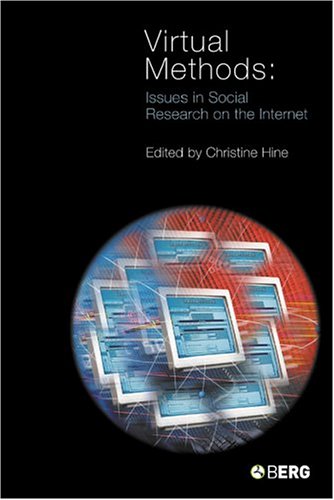Virtual Methods: Issues in Social Research on the Internet
Hine, Christine (Editor)
Berg, Oxford
2005
1845200853
 Virtual Methods is a comprehensive and interesting collection dealing with the issues and challenges when conducting social research online. The book is divided into two sections, each with seven chapters: part 1: Research Relationships and Online Relationships; and part 2: Research Sites and Strategies. The chapters range from discussing online interviewing and the relationship between researcher and researched; to the shift from an online relationship with participants to meeting them in real life; to considering anthropology in cyberspace; to the role of maps in virtual research methods.
As Hine argues in the introduction, 'virtual methods could act as interrogators of traditional method in a similar fashion: in pondering on whether a virtual interview qualifies as a real interview, we also can think more deeply about what it is that we valued about interviews as a methodological stance' (p.10). So the two are not mutually exclusive and can inform and enrich each other, being the same or similar in some ways, but very different in others.
Virtual Methods is a comprehensive and interesting collection dealing with the issues and challenges when conducting social research online. The book is divided into two sections, each with seven chapters: part 1: Research Relationships and Online Relationships; and part 2: Research Sites and Strategies. The chapters range from discussing online interviewing and the relationship between researcher and researched; to the shift from an online relationship with participants to meeting them in real life; to considering anthropology in cyberspace; to the role of maps in virtual research methods.
As Hine argues in the introduction, 'virtual methods could act as interrogators of traditional method in a similar fashion: in pondering on whether a virtual interview qualifies as a real interview, we also can think more deeply about what it is that we valued about interviews as a methodological stance' (p.10). So the two are not mutually exclusive and can inform and enrich each other, being the same or similar in some ways, but very different in others.
It is interesting to note that much CMC (Computer-Mediated Communication) research takes place over an extended period of time. A notable feature is the longevity of the contact between researcher and participants, perhaps in a way that real-life research doesn't necessitate. Why is it easier to establish trust in real-life? This is a question that Joinson and Kivits examine. Online research also demands strategies around disclosure and self-disclosure, for the researcher. For example, Orgad discusses maintaining both online and offline relationships with her participants, who were sufferers of breast cancer. Building trust, therefore, was an 'even thornier' issue (p.55). To start with, her University email address did not add to her credibility (as Sanders found in another chapter). Orgad found that the sensitive nature of her research made the balance difficult to maintain – her participants felt able to disclose details to her because they were online but did that make them friends? This also led to some discomfort for her participants about actually meeting her in the flesh.
Online participants were able to discuss the researchers as a group, in a way that real-life participants may not be able to do, and Sanders, and Rutter and Smith, found that established members of their particular online community came to their rescue – ultimately, that was what lent them the necessary credibility, not their University email address or their qualifications or anything else. Both chapters argue that this proves that people are significantly less trusting when approached online than they would be in equivalent real-life situations. This, then, raises important issues about access, research design, methods and ethics.
My only misgiving is that the book did not take the chance to examine exclusively empirical research, which, arguably, social research is all about. I would also have liked to have seen more about the ethical issues around social research online. Nonetheless, this is one of the most successful books about online research (and online social spaces) – alongside books in the Digital Formations series – and provides the internet researcher with ample material to embark on their project, whether they are already engaged in the field or about to begin. I recommend it to anyone who undertakes social research, in whatever discipline, and the book would also be of use to those with a general interest in the Internet.
Samantha Holland
Leeds Metropolitan University

